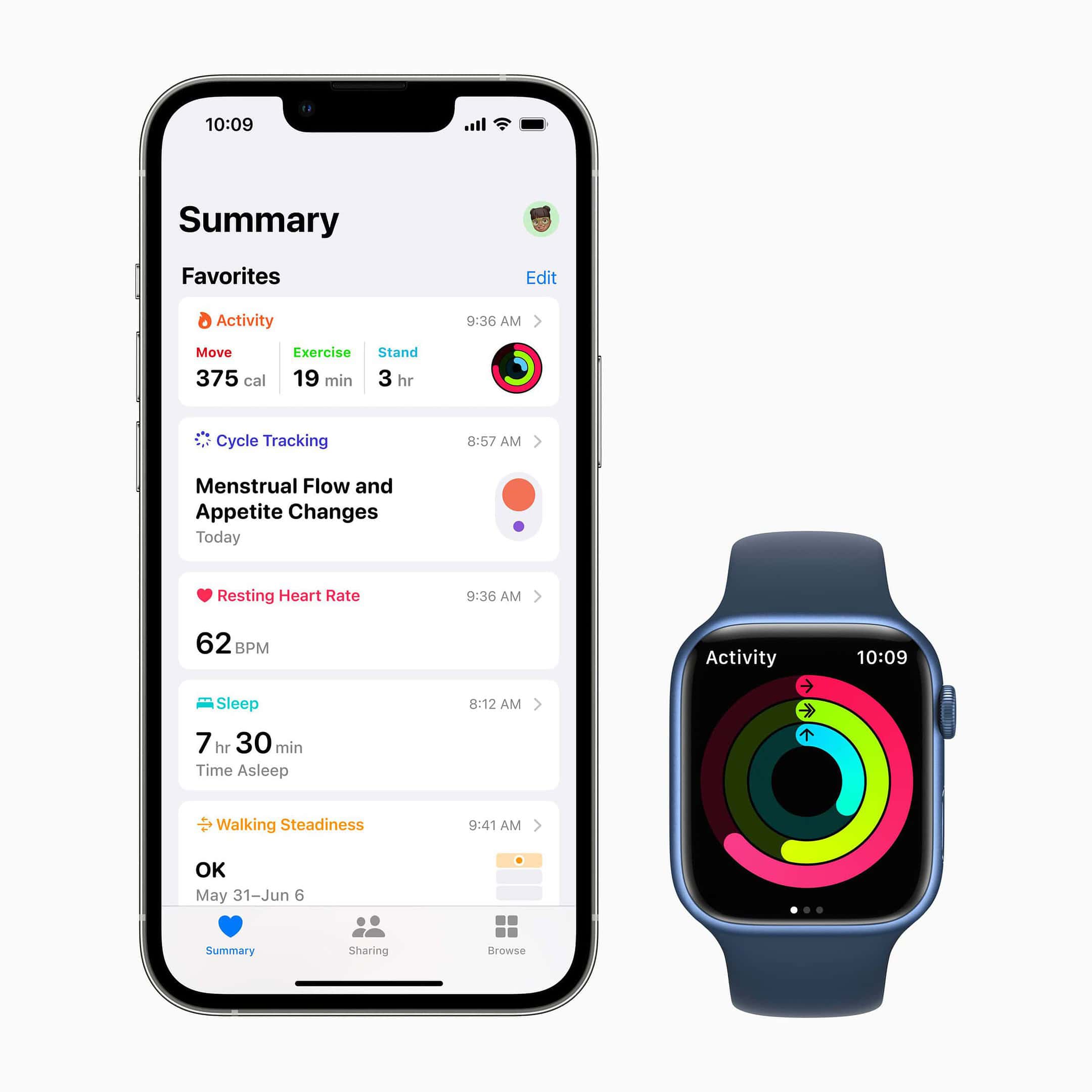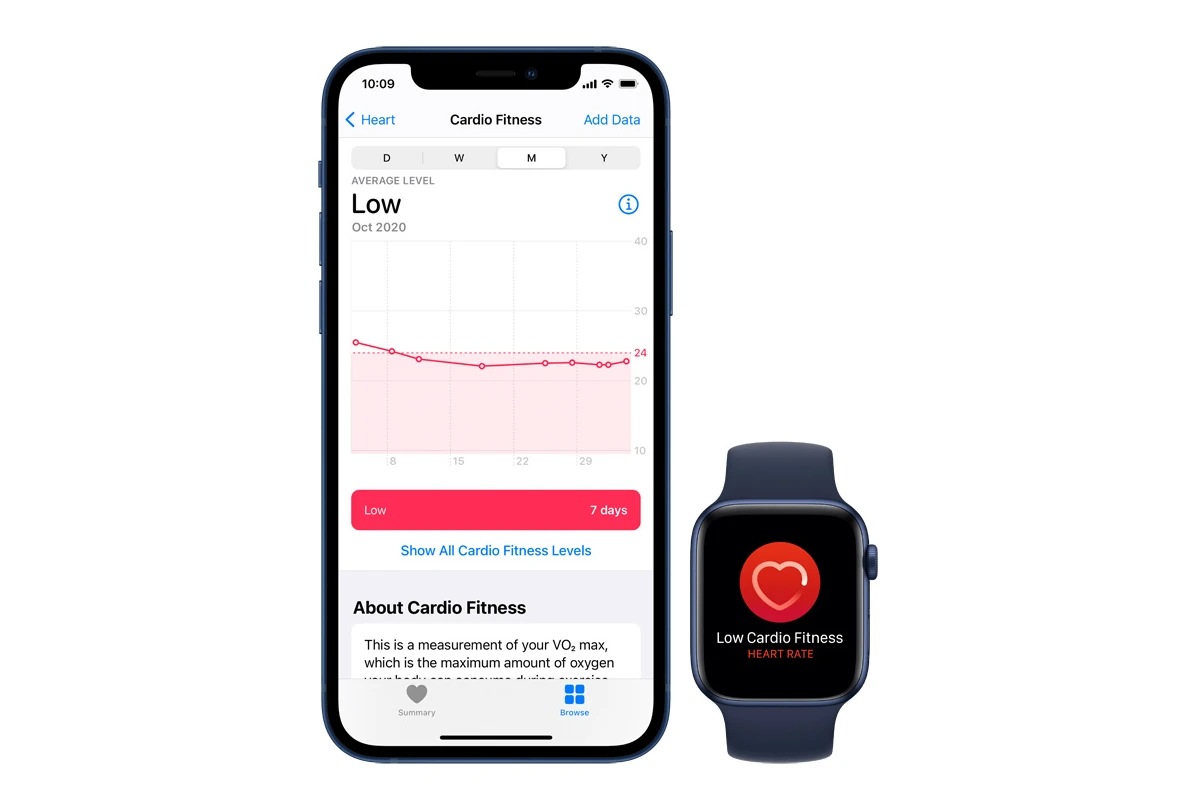The Apple Watch’s low cardio fitness alert has sparked interest and concern among users. This feature measures your VO2 max, a key indicator of cardiovascular health. Your Apple Watch can now warn you if your cardio fitness level is dangerously low, comparing your VO2 max to others in your age and sex group.
Many users wonder about the accuracy of this measurement. The Apple Watch estimates VO2 max using sensors and algorithms, but it’s not as precise as lab testing. Some users report their Apple Watch readings were 30% lower than lab results.

Despite potential inaccuracies, the cardio fitness feature can still be useful for tracking trends over time. It provides a general idea of your fitness level and can motivate you to improve. However, if you’re concerned about your cardio fitness, it’s best to consult a healthcare professional for a more accurate assessment.
| Cardio Fitness Level | VO2 Max Range (ml/kg/min) |
|---|---|
| Low | Below 30 |
| Below Average | 30-37 |
| Above Average | 38-45 |
| High | Above 45 |
Tips for Improving Your Score If Your Cardio Fitness Is Low on Apple Watch
Apple Watch tracks your Cardio Fitness using a metric called VO₂ max, which estimates how much oxygen your body can use during exercise. If your Apple Watch shows a low Cardio Fitness score, it means your aerobic endurance is below average for your age and gender — but the good news is that it’s very improvable with consistent lifestyle changes.
Here’s how you can boost your Cardio Fitness score:
1. Do More Brisk, Sustained Cardio Workouts
Apple uses outdoor walks, runs, or hikes that elevate your heart rate as primary VO₂ max data sources.
- Aim for at least 150 minutes of moderate or 75 minutes of vigorous activity per week.
- Activities that help:
- Brisk walking (power walking)
- Jogging or running
- Hiking on an incline
- Cycling at a moderate to fast pace
- HIIT workouts (with proper intensity and duration)
- Ensure your heart rate stays in the elevated zone for at least 20 minutes.
2. Track Workouts With the Right Settings
- Use the “Outdoor Walk,” “Outdoor Run,” or “Hike” workout types in the Workout app.
- Keep Location Services on and ensure Fitness Tracking and Heart Rate are enabled in:
- Settings > Privacy & Security > Location Services
- Settings > Privacy & Security > Motion & Fitness
3. Consistency Matters Most
- Apple Watch calculates VO₂ max based on multiple workouts over time.
- Try to get in at least 2–3 cardio sessions per week for steady improvements.
- After a few weeks of consistency, you should start to see your Cardio Fitness score rise.
4. Improve Workout Intensity Gradually
If your workouts aren’t getting your heart rate up enough, your VO₂ max won’t improve much.
- Use your Apple Watch to monitor heart rate during workouts.
- Work toward Zone 2 and Zone 3 heart rate training (moderate to vigorous).
- Slowly increase pace, incline, or duration to challenge your cardiovascular system.
5. Optimize Your Recovery and Sleep
- Your heart and lungs recover during rest, so quality sleep and stress management play a role.
- Use the Mindfulness and Sleep apps on your Apple Watch to help improve overall recovery.
6. Maintain a Healthy Weight and Diet
- Extra body weight can reduce your VO₂ max.
- Eating a heart-healthy diet rich in fruits, vegetables, lean proteins, and whole grains supports better cardio output.
7. Avoid Smoking and Limit Alcohol
Both can significantly impair cardiovascular health and reduce your ability to improve VO₂ max.
8. Give It Time
- It may take 6–8 weeks of consistent effort to see significant changes.
- Apple Watch updates your VO₂ max score over time — usually after 2–3 intense outdoor workouts.
Bonus Tip: Compare with Apple Health Benchmarks
- Go to the Health app > Browse > Heart > Cardio Fitness
- Tap “Cardio Fitness Levels” to compare your current score to Apple’s reference ranges for your age and gender.
If your score stays low despite regular exercise, it may be worth discussing with a doctor — low VO₂ max can be linked to underlying health conditions. But for most people, improving cardio fitness is just a matter of consistency, effort, and time.
Understanding Cardio Fitness
Cardio fitness is a key indicator of your overall health and physical condition. It measures how well your body uses oxygen during exercise and daily activities.
What Is Cardio Fitness?
Cardio fitness, also known as cardiovascular fitness or aerobic fitness, refers to your heart and lungs’ ability to supply oxygen to your muscles during sustained physical activity. It’s closely linked to VO2 max, which is the maximum amount of oxygen your body can use during intense exercise.
Your cardio fitness level affects your endurance and stamina. A higher level means you can exercise longer and harder without getting tired. It also helps you recover faster after workouts.
Improved cardio fitness can lead to better performance in sports and daily activities. It allows you to climb stairs, carry groceries, or play with your kids without feeling winded.
Why Cardio Fitness Matters
Cardio fitness is crucial for your long-term health and well-being. It reduces your risk of heart disease, stroke, and diabetes. A higher cardio fitness level can also lower your blood pressure and improve your cholesterol levels.
Regular cardio exercise strengthens your heart muscle. This allows it to pump more blood with each beat, improving your overall circulation. Better circulation means your body can deliver oxygen and nutrients to your cells more efficiently.
Cardio fitness also boosts your mental health. Exercise releases endorphins, which can improve your mood and reduce stress. It may even help prevent cognitive decline as you age.
| Benefits of High Cardio Fitness |
|---|
| Reduced risk of heart disease |
| Improved blood pressure |
| Better cholesterol levels |
| Enhanced mood and mental health |
| Increased energy and stamina |
Cardio Fitness Levels and VO2 Max
Cardio fitness levels are often measured using VO2 max. This is the maximum amount of oxygen your body can use during intense exercise, usually expressed in milliliters of oxygen per kilogram of body weight per minute.
Your Apple Watch estimates your VO2 max based on your heart rate during outdoor walks, runs, or hikes. It then compares this to average levels for your age and sex to determine your cardio fitness level.
Cardio fitness levels are typically categorized as low, below average, average, above average, or high. A higher level indicates better cardiovascular health and fitness.
Improving your cardio fitness level takes time and consistent effort. Regular aerobic exercise like running, cycling, or swimming can help increase your VO2 max and overall cardio fitness.
Factors Influencing Cardio Fitness
Several factors affect your cardio fitness level. Age is a significant factor, as VO2 max tends to decline with age. However, regular exercise can slow this decline.
Sex also plays a role. Men typically have higher VO2 max values than women due to differences in body composition and heart size.
Your genetics influence your natural cardio fitness level and how quickly you can improve it. Some people may see faster results from training than others.
Altitude can impact cardio fitness. Living or training at high altitudes can increase your VO2 max as your body adapts to lower oxygen levels.
Diet and body composition also affect cardio fitness. Excess body fat can lower your VO2 max relative to your weight. A balanced diet supports your exercise efforts and helps maintain a healthy weight.
Apple Watch as a Fitness Tracker
The Apple Watch serves as a powerful fitness tracking device with advanced features for monitoring health and activity. Its sensors and technologies work together to provide users with valuable insights into their physical well-being.
Monitoring with Apple Watch
Apple Watch offers comprehensive fitness tracking capabilities. It monitors daily activity levels, including steps taken, calories burned, and minutes of exercise. The device tracks various workout types such as running, cycling, swimming, and yoga.
Users can set personalized fitness goals and receive notifications to encourage regular movement. The watch’s Activity Rings feature visually displays progress towards daily Move, Exercise, and Stand goals.
The Workout app on Apple Watch allows you to start and track specific exercises. It provides real-time metrics like heart rate, distance, and pace during workouts.
Accuracy and Estimations
Apple Watch uses complex algorithms to estimate fitness metrics. Its VO2 max measurements can sometimes be lower than lab-tested results. The device supports a VO2 max range of 14-65 mL/kg/min for users 20 years or older.
Accuracy may vary depending on factors like workout intensity and individual physiology. For most users, the watch provides reliable data for tracking fitness trends over time.
To improve accuracy:
- Wear your watch snugly
- Update your personal information regularly
- Calibrate the watch for outdoor workouts
The Heart Rate Sensor and Other Technologies
The optical heart rate sensor is a key component of Apple Watch’s fitness tracking abilities. It uses green LED lights and light-sensitive photodiodes to detect blood flow in your wrist.
Other important technologies include:
- Accelerometer: Measures body movement and steps
- Gyroscope: Detects orientation and rotation
- GPS: Tracks location during outdoor workouts
- Altimeter: Measures elevation changes
These sensors work together to provide a comprehensive picture of your physical activity and health.
Compatibility with Health Apps
Apple Watch integrates seamlessly with the Health app on iPhone. This app serves as a central hub for all your health and fitness data. It displays information collected by your watch, including activity, workouts, heart rate, and sleep patterns.
The Health app allows you to:
- View detailed charts and trends
- Set up health features like Cardio Fitness notifications
- Share data with healthcare providers
Many third-party fitness apps also work with Apple Watch. These apps can access watch data to provide additional insights and features. Popular options include Strava, MyFitnessPal, and Nike Run Club.
| Feature | Description |
|---|---|
| Activity Tracking | Monitors daily movement, exercise, and standing |
| Workout App | Tracks specific exercises with real-time metrics |
| Heart Rate Monitoring | Continuously measures heart rate during activity and rest |
| GPS | Tracks outdoor workout routes and distances |
| Health App Integration | Centralizes all health and fitness data on iPhone |
Maximizing Fitness with Apple Watch
The Apple Watch offers powerful tools to enhance your fitness journey. It helps you set goals, track activities, and improve your overall health.
Setting and Reaching Fitness Goals
Your Apple Watch can be a key ally in achieving fitness targets. Start by setting up custom goals in the Fitness app. Choose daily move, exercise, and stand goals that challenge you without being unrealistic.
Use the rings system to visualize your progress. Close your rings daily to build a streak and stay motivated. The watch will send notifications to keep you on track.
Consider joining challenges with friends or participating in Apple’s monthly competitions. These add a fun, social element to your fitness routine.
Table: Apple Watch Fitness Goals
| Goal Type | Description | Customization |
|---|---|---|
| Move | Active calories burned | Set target calories |
| Exercise | Minutes of brisk activity | Adjust time goal |
| Stand | Hours with standing activity | Fixed at 12 hours |
Tracking Workouts and Activity
The Workout app on your Apple Watch is a versatile fitness tracker. It supports various activities like walking, running, cycling, and swimming.
To start a workout, open the app and select your activity. The watch will track metrics such as heart rate, distance, and calories burned. For outdoor workouts, it uses GPS to map your route.
Your watch also tracks daily activity automatically. It records steps, flights climbed, and periods of standing. This data syncs to the Health app on your iPhone for a comprehensive view of your fitness.
Adding a Workout complication to your watch face allows quick access to start tracking.
Integrating Health Recommendations
Apple Watch goes beyond tracking to provide personalized health insights. It monitors your heart rate throughout the day and can alert you to irregularities.
The watch measures your cardio fitness level using VO2 max estimates. This metric helps you understand your overall fitness and track improvements over time.
Sleep tracking is another valuable feature. Set a sleep schedule and your watch will help you meet your goals. It provides a breakdown of your sleep stages and trends over time.
Use the Breathe app for guided mindfulness sessions. Regular practice can help reduce stress and improve focus.
Improving Cardio Fitness Over Time
Your Apple Watch can help boost your cardio fitness level. Start by checking your current cardio fitness score in the Health app.
To improve, focus on increasing the intensity and duration of your workouts. Mix high-intensity interval training with longer, steady-state cardio sessions.
The watch will track your progress and notify you of changes in your cardio fitness level. It may suggest ways to improve, such as increasing your daily activity or trying new workout types.
Remember, consistency is key. Aim for regular exercise sessions and gradually increase their difficulty. Your Apple Watch will be there to guide and motivate you every step of the way.
Health Insights and Notifications
The Apple Watch offers valuable health insights and notifications to help you monitor your cardio fitness. These features provide personalized alerts, data interpretation, and guidance on when to seek medical advice.
Personalized Fitness Notifications
Your Apple Watch can send you a notification if your cardio fitness level is low. This feature helps you stay informed about your overall health. The watch measures your VO2 max, which is the maximum amount of oxygen your body can use during exercise.
To enable these notifications:
- Open the Health app on your iPhone
- Tap “Browse” then “Heart”
- Select “Cardio Fitness”
- Turn on “Low Cardio Fitness Notifications”
These alerts can be especially helpful if you’re at risk for conditions like heart disease, diabetes, or high blood pressure.
Interpreting Data and Taking Action
The Health app provides a clear view of your cardio fitness data. It shows whether your level is high, above average, below average, or low compared to people of your age and sex.
Here’s a simple guide to interpreting your results:
| Cardio Fitness Level | What It Means |
|---|---|
| High | Excellent cardiovascular health |
| Above Average | Good cardiovascular health |
| Below Average | Room for improvement |
| Low | Potential health risks |
If your level is low, consider increasing your physical activity. Even small changes like taking the stairs instead of the elevator can make a difference.
Consulting Healthcare Providers
While the Apple Watch provides valuable insights, it’s not a substitute for professional medical advice. If you receive a low cardio fitness notification, it’s wise to consult your doctor.
Your healthcare provider can:
- Assess your overall health
- Recommend appropriate exercises
- Discuss potential medications if needed
- Address any underlying conditions
Remember, factors like pregnancy or certain medications can affect your VO2 max readings. Always provide your doctor with your Apple Watch data for a comprehensive health assessment.
Frequently Asked Questions
Apple Watch users often have questions about their cardio fitness scores and how to interpret them. Let’s address some common concerns and provide practical advice for improving cardiovascular health.
How can I improve my cardio fitness score on the Apple Watch?
To boost your cardio fitness score, focus on regular aerobic exercise. Aim for at least 150 minutes of moderate-intensity activity per week. Mix up your workouts with activities like brisk walking, jogging, cycling, or swimming. Gradually increase the duration and intensity of your exercises.
Add interval training to your routine. This can help improve your VO2 max more effectively than steady-state cardio alone. Try alternating between short bursts of high-intensity effort and recovery periods.
What factors could lead to a low cardio fitness notification on the Apple Watch?
Several factors can contribute to a low cardio fitness alert on your Apple Watch. These include a sedentary lifestyle, being overweight, smoking, and poor sleep habits. Certain medical conditions like heart disease or respiratory issues may also affect your score.
Age and genetics play a role in cardio fitness levels. As you get older, your VO2 max naturally declines. Some people may have a genetic predisposition to lower cardio fitness scores.
Is the cardio fitness feature on Apple Watch reliable for pregnant women?
The cardio fitness feature may be less accurate for pregnant women. Pregnancy causes significant changes in the cardiovascular system, including increased blood volume and heart rate. These changes can affect VO2 max measurements.
Consult with your healthcare provider about using the Apple Watch cardio fitness feature during pregnancy. They can offer personalized advice based on your health status and stage of pregnancy.
How does Apple Watch calculate my cardio fitness level?
Apple Watch estimates your cardio fitness level using your heart rate and motion sensors during outdoor walks, runs, or hikes. It calculates an estimate of your VO2 max, which represents the maximum amount of oxygen your body can use during exercise.
The watch takes into account factors like your age, gender, weight, and activity level to provide a more accurate estimate. For best results, wear your watch snugly and use it consistently during workouts.
Can medical conditions like asthma affect my cardio fitness score on Apple Watch?
Yes, medical conditions like asthma can impact your cardio fitness score. Asthma can limit your lung function and oxygen uptake during exercise, potentially leading to a lower VO2 max reading.
If you have asthma or other respiratory conditions, discuss your Apple Watch cardio fitness readings with your doctor. They can help interpret the results in the context of your overall health.
What actions should I take if my Apple Watch indicates a low cardio fitness score?
If your Apple Watch shows a low cardio fitness score, don’t panic. Start by gradually increasing your physical activity. Set realistic goals and work towards them consistently.
Consider consulting a healthcare professional or certified fitness trainer. They can help create a safe and effective exercise plan tailored to your needs. Remember to make lifestyle changes like improving your diet and getting enough sleep.
| Action | Benefit |
|---|---|
| Regular cardio | Improves heart and lung function |
| Strength training | Boosts overall fitness and metabolism |
| Healthy diet | Supports cardiovascular health |
| Adequate sleep | Enhances recovery and overall well-being |
| Stress management | Reduces negative impact on heart health |







